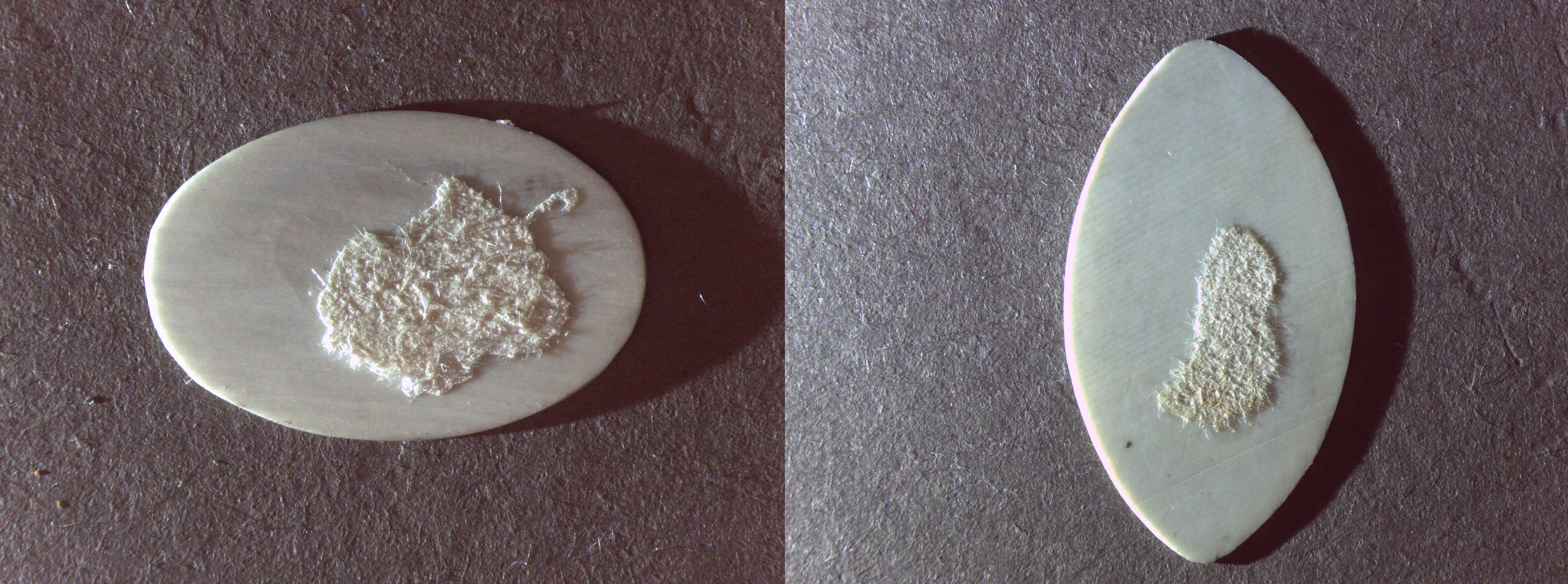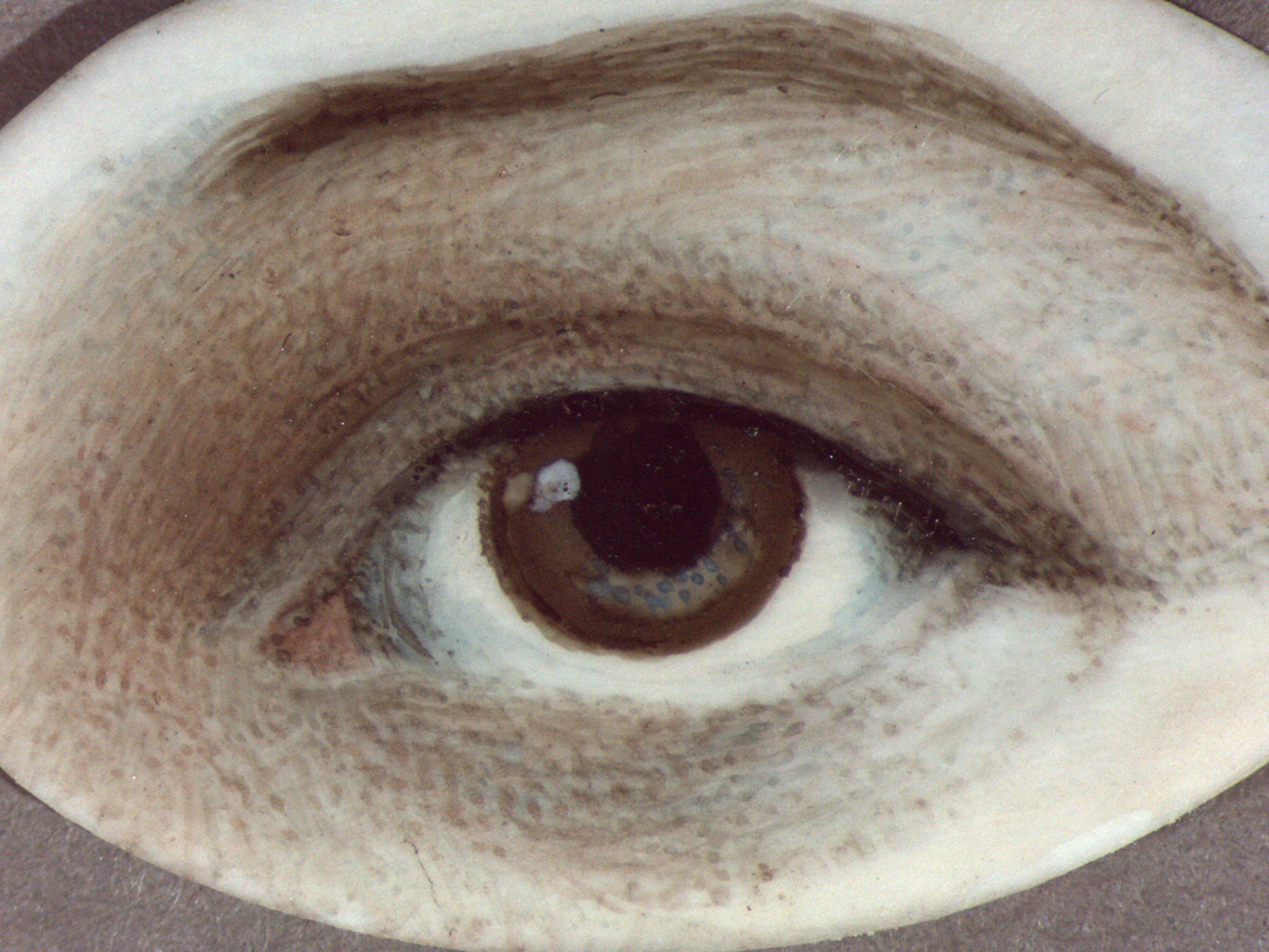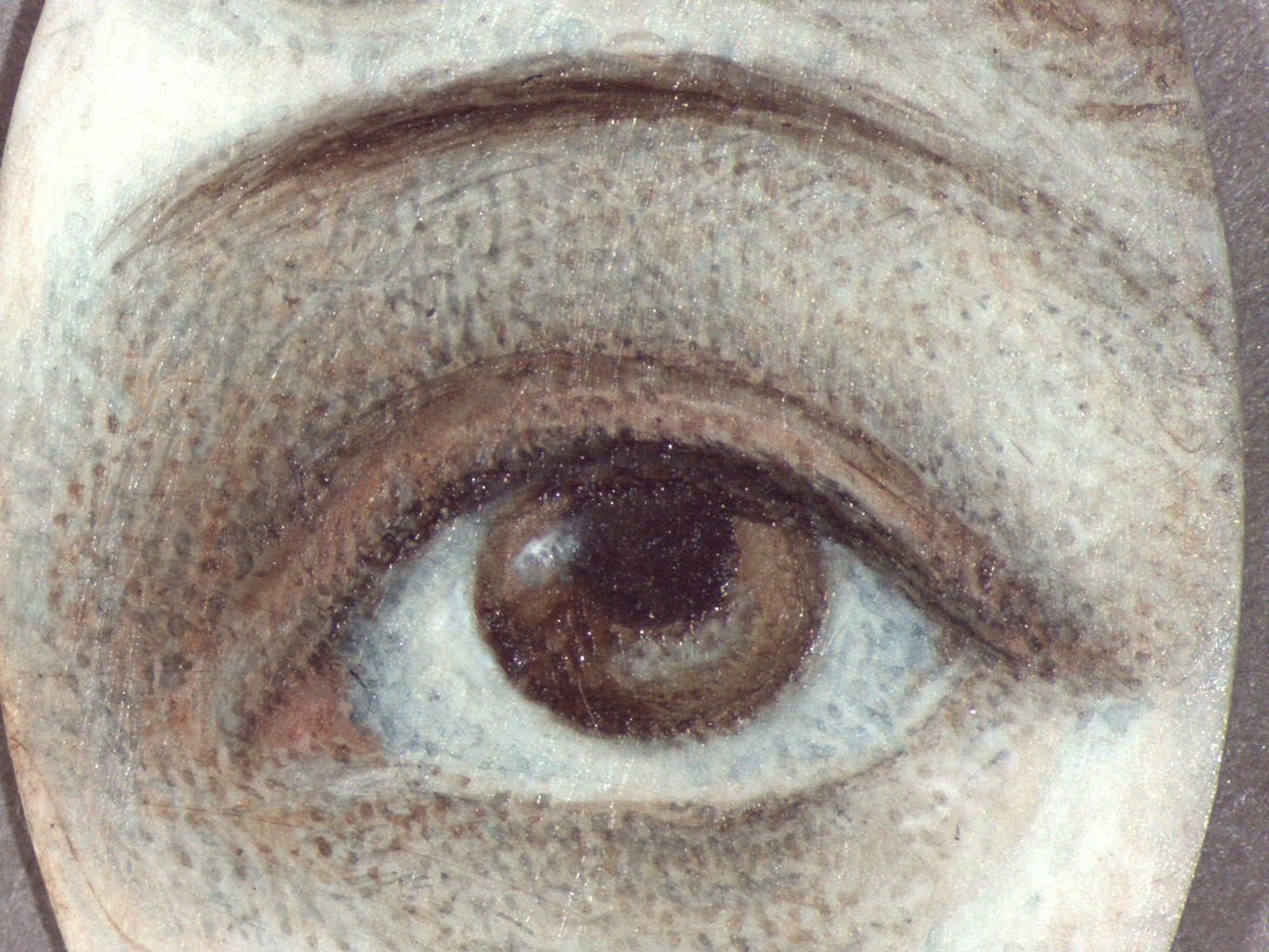Citation
Chicago:
Maggie Keenan, “Unknown, Eye Miniature, early 20th century,” catalogue entry in Aimee Marcereau DeGalan, Blythe Sobol, and Maggie Keenan, The Starr Collection of Portrait Miniatures, 1500–1850: The Collections of the Nelson-Atkins Museum of Art, vol. 1, ed. Aimee Marcereau DeGalan (Kansas City, MO: Nelson-Atkins Museum of Art, 2024), https://doi.org/10.37764/8322.5.4118.
MLA:
Keenan, Maggie. “Unknown, Eye Miniature, early 20th century,” catalogue entry. Aimee Marcereau DeGalan, Blythe Sobol, and Maggie Keenan. The Starr Collection of Portrait Miniatures, 1500–1850: The Collections of the Nelson-Atkins Museum of Art, edited by Aimee Marcereau DeGalan, vol. 1, Nelson-Atkins Museum of Art, 2024. doi: 10.37764/8322.5.4118.
Catalogue Entry
The twentieth-century artist of this miniature in an oval-shaped case with pearl surround may have intended it to resemble a work from the early nineteenth century by placing it in an earlier bezel: A groove that holds the object in its setting. More specifically, it refers to the metal that holds the glass lens in place, under which the portrait is set..1Conservator Carol Aiken suggested a date of “very late 19th century or early 20th century,” according to a March 19–23, 2018, conversation; notes in NAMA curatorial files. The miniature is reminiscent of John Cox Dillman Engleheart’s (English, 1784–1862) ca. 1810 painting of his sister’s eye,2See John Cox Dillman Engleheart (1784–1862), The Left Eye of the Artist’s Sister, Mary Cox Dillman Engleheart, ca. 1810, watercolor on ivory, 3/4 in. (19.9 cm), sold at Christie’s “Important Gold Boxes, Objects and Portrait Miniatures,” December 10, 2002, lot 285, https://www.christies.com/en/lot/lot-4020346. although they do not share the same level of detail or method of paint application. The artist of this miniature uses a more modern technique of heavy stippling: Producing a gradation of light and shade by drawing or painting small points, larger dots, or longer strokes., rather than Engleheart’s softened brushwork and further developed palette.
The Nelson-Atkins miniature was probably created as a souvenir to target a ready audience of fashionable buyers during the resurgence of eye miniatures in the early 1900s. Painted with a scattered spray of brown dots, another eye miniature in the Starr Collection (Fig. 1, F58-60/196), this one a navette: Boat-shaped jewelry, often seen as rings from the Victoria era. Not to be confused with marquise jewelry, which often describes the shape of the stone and not the setting. with pearl surround, shares a similar narrative: its early twentieth-century image was placed in a comparable bezel that is also likely of nineteenth-century origin.3Aiken, March 19–23, 2018.
Photomicrographs reveal that both eyes share the same slim brow, consisting of horizontal brushstrokes that reach the width of both eyes; the brow bends like the arch of the upper eyelid (Figs. 2, 3). Below the imperfectly shaped pupils are curves of faint brown, filled with speckles of pigment: darker brown dots in the navette and blue-gray in the oval miniature. The approach to the inner tear ducts, the blue shading around the eyeballs’ edges, the lower-lid waterlines, and the crescent-shaped shadows beneath are the same for both miniatures.
While it is difficult to say for certain whether the same artist created the two eyes, it is clear they share a monochromatic palette and similar application of stippled paint. Another factor possibly connecting these miniatures was the discovery of a fibrous material present on the verso of both ivory: The hard white substance originating from elephant, walrus, or narwhal tusks, often used as the support for portrait miniatures. supports (Fig. 4).4This discovery occurred on November 17, 2021, during treatment by conservator Stephanie Spence. Notes in NAMA curatorial files. These are the partial remnants of paper backing cards that are no longer with the miniatures. Backing cards were often applied to the backs of ivory miniatures or slipped in behind them in order to better fill the case and secure the ivory. It is possible the works passed through the same hands at some point and were reframed to better resemble Georgian-era fashion; the backing cards may have been removed in the process.5There is currently no known provenance for either object.

While there are many stylistic and material similarities between these two miniatures, their settings are different. The navette-shaped eye was worn as a ring, and the oval eye was likely intended to hold a fichu: From the French ficher (“to fix”), a fichu is a large triangular or square lace or muslin kerchief worn by women to fill in the low neckline of a bodice.. Nevertheless, they were probably both created as decorative souvenirs, popular during the early twentieth century and recalling an earlier trend.
Notes
-
Conservator Carol Aiken suggested a date of “very late 19th century or early 20th century,” according to a March 19–23, 2018, conversation; notes in NAMA curatorial files.
-
See John Cox Dillman Engleheart (1784–1862), The Left Eye of the Artist’s Sister, Mary Cox Dillman Engleheart, ca. 1810, watercolor on ivory, 3/4 in. (19.9 cm), sold at Christie’s “Important Gold Boxes, Objects and Portrait Miniatures,” December 10, 2002, lot 285, https://www.christies.com/en/lot/lot-4020346.
Aiken, March 19–23, 2018.
-
This discovery occurred on November 17, 2021, during treatment by conservator Stephanie Spence. Notes in NAMA curatorial files.
-
There is currently no known provenance for either object.
Provenance
Mr. John W. (1905–2000) and Mrs. Martha Jane (1906–2011) Starr, Kansas City, MO, by 1958;
Their gift to The Nelson-Atkins Museum of Art, Kansas City, MO, 1958.
References
Ross E. Taggart, The Starr Collection of Miniatures in the William Rockhill Nelson Gallery (Kansas City, MO: Nelson Gallery-Atkins Museum, 1971), no. 215, p. 72, (repro.), as Eye Miniature.
No known exhibitions. If you have additional information on this object, please tell us more.

